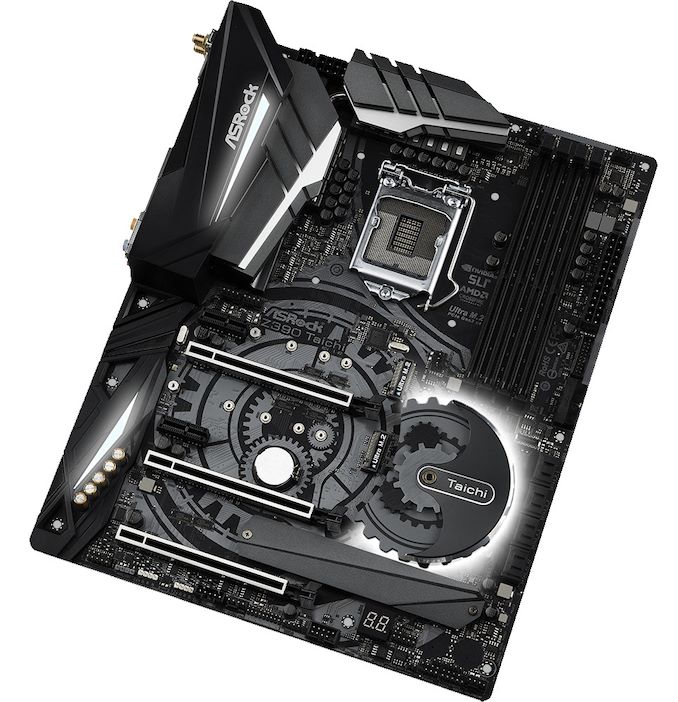The ASRock Z390 Taichi Review: Jack of All Trades, Master of None
by Gavin Bonshor on November 1, 2018 9:00 AM EST- Posted in
- Motherboards
- Intel
- ASRock
- Taichi
- Coffee Lake
- i7-8700K
- Z390
- Dual NIC
- Z390 Taichi
ASRock Z390 Taichi Conclusion
The ASRock Z390 Taichi is the direct successor to the previous Z370 Taichi model and is once again targeted towards the upper end of mid-range motherboards in the Z390 range. The new Z390 Taichi has a recommended retail price of $240, which is a $20 increase over what the Z370 model cost. Both models share similar feature sets with dual Intel Gigabit NIC, integrated 802.11ac Wi-Fi capabilities, PCIe layout and have striking designs which are very similar to each other.
If the previous Z370 Taichi is taken out of the equation, then the Z390 looks very strong in its contested price point in terms of features. Without taking much away from the new Phantom Gaming series of motherboards from ASRock, the Taichi Z390 looks to combine basic elements to create a solution which is good at many things, but doesn't necessarily master in one. The dual Gigabit NIC with teaming support offers users looking to create up to an eight-core workstation with something to consider, while the robust 12-phase power delivery, and DDR4-4200 memory support look to satisfy the needs of the enthusiast. Of course gamers aren't left out with two-way SLI and up to three-way CrossFire multi-graphics configurations supported. Storage capabilities consist of three PCIe 3.0 x4 M.2 drives and a total of eight SATA ports; six driven by the Z390 chipset and the other two from an ASMedia ASM1061 SATA controller.

The Z390 chipset on the ASRock Z390 Taichi
The ASRock Z390 Taichi does make use of the Z390's newly implemented native USB 3.1 Gen2 connectivity with a total of three USB 3.1 Type-A on the rear panel, with a single USB 3.1 Gen2 Type-C port being made available by virtue of an ASMedia ASM1543 Type-C controller. An additional four rear-panel USB 3.0 Type-A ports are provided by a pair of Diodes PI3EQX USB 3.1 Gen2 re-drivers. The auditory side is taken care of by the premium Realtek ALC1220 HD audio codec, but is rather let down by the lack of any decent software to drive it; this is something ASRock shouldn't be letting slide on a $140 option, let alone one that costs $240. One of the two inclusive LAN ports is powered by an Intel I219-V, while the second port is controlled by an I211-AT NIC. The wireless adapter is the Intel 3168NGW 802.11ac Wi-Fi which is capable of supporting speeds up to 433 Mb/s.
For performance, the Taichi is as the middle of the road as they come. There are no real issues in regards to system performance with the Z390 Taichi performing well in POST times and sitting mid-table in terms of DPC latency. There was always going to be a slight variation given the decision to upgrade the benchmark suite and as such, POV-Ray performance is looking better with tweaks and updates to our Windows 10 OS install; this looks to be a factor in our 7-Zip encoding benchmark and a change to our WinRAR 5.40 test had a somewhat negative impact on things. Overclocking performance en masse was pretty good too all things considered, especially if you discount the pre-defined overclocking profiles provided through the ASRock EZ OC setting. It offered way too much voltage for diminishing returns due to extra heat caused problems. Manual overclocking was much more efficient in terms of heat, power and stability.
For its competition in the market, it is worth noting that some of the more moderately priced ASRock boards such as the Z390 Phantom Gaming SLI/ac ($170) and the Phantom Gaming 6 ($196) managed to include the new Realtek 2.5G NIC, although on the Taichi there are dual Intel NICs. For $240 the ASRock Z390 Taichi does offer more visually neutral aesthetics than other models and it does include the added option of holding a rainbow themed party inside a users system, but without being too garish. The main competition comes from the GIGABYTE Z390 Aorus Ultra ($250) and MSI's MPG Z390 Gaming Pro Carbon AC ($230). The crux of it all lies on the Z390 Taichi's laurels with a decent showing all-around, but not technically standing out as being highly proficient or specializing in any particular niche.











11 Comments
View All Comments
James5mith - Thursday, November 1, 2018 - link
It's either Ashes of The Singularity and AoTS, or Ashes of the Singularity and AotS.Don't mix the two.